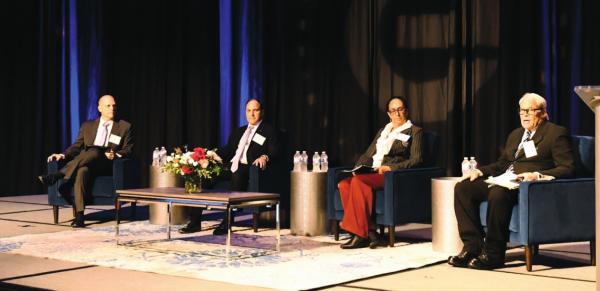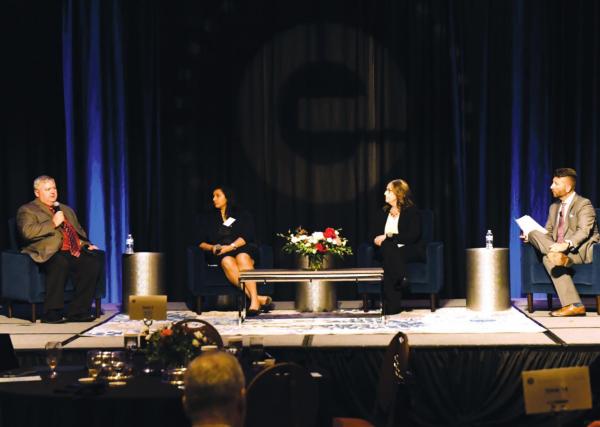Forecasting the region’s economy
The Greater San Marcos Partnership hosted its annual Economic Outlook Conference to discuss national and regional expectations for 2022, looking ahead at a third pandemic year.
As the regional economic development organization for Hays and Caldwell Counties since 2010, the GSMP actively markets and fosters entrepreneurial growth in the region — commonly referred to as the Texas Innovation Corridor. Its annual conference in San Marcos on Thursday, Dec. 9, brought in economic experts and local business leaders to examine factors expected to impact the region’s economy over the next year. The event featured two moderated panel discussions, in addition to a brief question and answer session and an economic development update from the GSMP.
The first of the two panels, the Economic Outlook Panel, mainly focused on national economic trends in light of COVID-19.
Since the pandemic began in March of 2020, the economy was altered through a series of policy and fiscal decisions made by the government. A lot of its changes are here to stay, said Thomas Bergeron, senior fund manager and senior research analyst at Frost Bank.
“With the stimulus checks, many were able to pay off existing debt they had accumulated,” Bergeron said. “With debt reduction, stimulus checks, and a higher savings rate, citizens are starting to feel wealthier. So, United States consumers are in good shape and have the capacity to spend.”
As a result, he said, the future of the economy is trending above its pre-pandemic levels, with strong GDP growth expected to continue.
“Over the last 16 years, the U.S. has experienced two recessions: in 2008/2009 and in 2020,” Bergeron explained. “What’s different from 2008 is that instead of 10 years, the bounce back from 2020 only took 15 months.”
A fellow senior research analyst from Frost Bank, Jonathan Waite, joined in on the conversation to address labor shortages, supply-chain shortages and inflation.
“There are a few things we think could be a hitch, COVID-19 and its Omicron variant being one of them,” he said. “It’s a matter of getting folks back to work, and I think we’re getting there, but there are just so many job openings. With supply chain issues, I think we’ve turned a corner, but we won’t see a resolution before mid-2022.”
As for inflation, Waite said he sees the current rates of 6–7% to be a peak for the U.S. economy.
“Where we’d been chugging along at 1–2% was good, so this recent 6–7% inflation has been a shock to people — and there’ll probably be political fallout,” he explained. “Internally, we’re not as worried. It should go down to 3–4% within the next few months and into next year.”
Not all industries have been equally affected by the high inflation rate, said Belinda Roman, professor of economics at St. Mary’s University.
“Retail, manufacturing and construction have been able to escape some of the inflation pressure,” she said. “We are starting to see a lot more small businesses popping up in the wake of COVID-19. The benefit of being in this particular region is the flexibility and space to expand.”
In the economic development update, GSMP President Jason Giulietti reported a 40% increase in labor opportunities, largely the result of large businesses and facilities moving into the area and diversifying the economy.
“Our region is seeing success at levels we’ve never seen, with Hays County the fastest growing county in the country [among counties with over 100,000 residents],” he said.
The event concluded with the Unique Perspectives Panel, where local business leaders shared how they accommodated major economic changes. Each discussed a noticeable change in labor force expectations, partially impacted by Generation Z’s entrance into the workforce.
“The initial slowdown really only affected us the first couple of months, but we really had to pivot with our internal operations and communication,” said Jessica Rudman, branch manager at Priority Personnel. “Gen Z wants everything faster, and that’s affected how we do job applications [with online applications and virtual interviews]. But impersonalizing the process also affects retention.”
The idea of working from home presents a significant barrier to resolving the labor shortage, as many have found virtual employment to be more convenient, said Shilpa Amin, owner of Stonebridge Hotels, LLC.
“We’ll never go back to where we were in 2019,” added Donny Hirsch, director of corporate manufacturing at Thermon Industries. “COVID-19 advanced a lot of generational expectations, and these will continue to develop and evolve. Some people will come back to the office, but some will find it easier to stay at home.”
“We feel like we have lost a pocket of the workforce, and we need to find ways to reach them,” Rudman said. “And then we need to find ways to keep them.”



